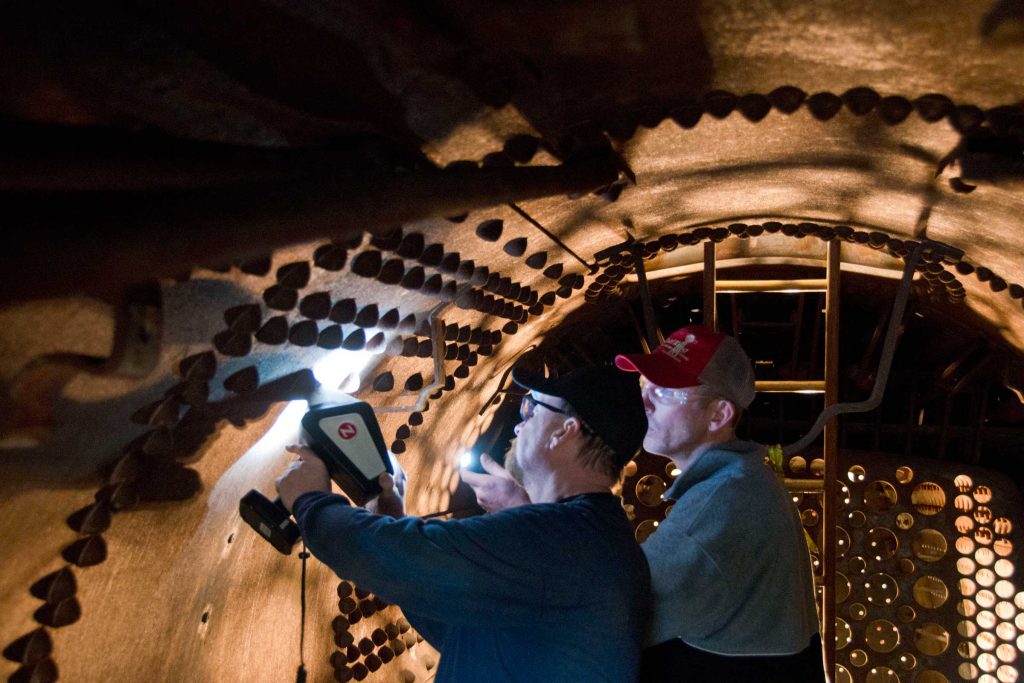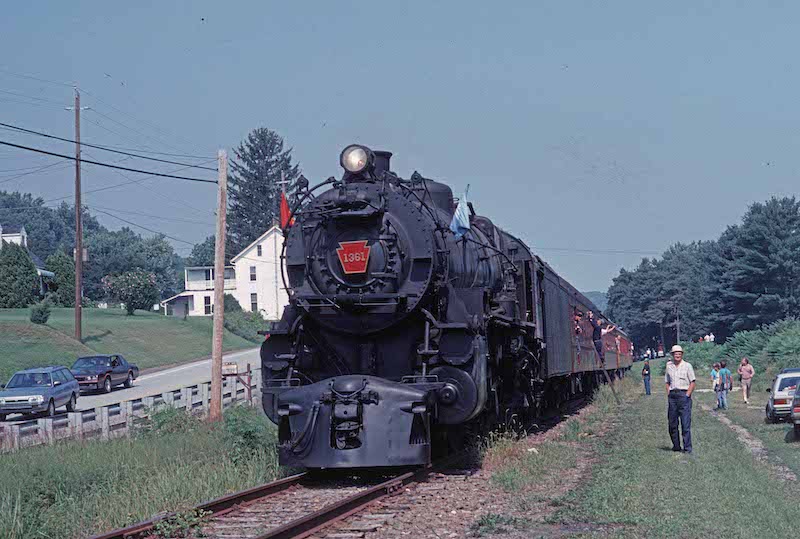By M.T. Burkhart
ALTOONA, Pa. – With a new board and renewed enthusiasm, one of the most iconic steam locomotives in the United States is finally poised for a comeback.
Under the direction of refreshed leadership at the Railroaders Memorial Museum in Altoona, Pennsylvania Railroad K4s 4-6-2 1361 is being prepared for a $2.6 million restoration. The finished product is expected to roam as a traveling educational exhibit and economic stimulus tool.
PRR 1361 was one of 425 K4 locomotives built in Altoona. Some of this class were used until the end of Pennsy steam in 1957, concentrated on New Jersey commuter runs. Retired in 1956 after racking up nearly 2.5 million miles, 1361 was displayed on the famous Horseshoe Curve for 28 years before being initially restored to service at Conrail’s Altoona Car Shop by a team of volunteers and contractors.
In April 1987, 18 months after being pulled from display on the mountain, the K4 ran a 90-mile round trip to Bellefonte, Pa. on Conrail and shortline Nittany & Bald Eagle. In late summer 1988, the locomotive was moved to York, Pa. for a series of trips over the old Northern Central.
During its return to Altoona, one of the axles overheated. A replacement was constructed and sent to Latrobe, Pa., where arrangements were made to have a keyway, or a notch, cut into it, so the drive wheel could fit in and function properly, according to the museum. In August 1989, the axle was damaged when it fell off the delivery truck, halting hopes of immediate further excursions.

Workers conduct a metallurgical analysis on PRR K4 1361. Photo Courtesy of FMW Solutions.
The engine was eventually sent to Steamtown National Historic Site for reconstruction after some state grants were secured during the 1990s and 2000s. After little headway, the locomotive was returned in pieces to the Railroaders Memorial Museum beginning in 2007. And for more than a decade, the K4 languished as enthusiasm and funds dried up, awaiting the right moment for another attempt.
The 30-year saga has seen multiple project managers, with considerable work completed. But there have been numerous setbacks and challenges. The latest studies showed that some of the rivets used in the boiler were of the incorrect steel; the repair and subsequent re-repair of the main dome course needed further inspection; and some firebox repairs were completed with improperly sized materials, the museum said.
“K4 1361 has a checkered 30-year restoration history,” Museum Board Chairman and former Norfolk Southern CEO Wick Moorman writes on the museum’s website. “Since running last in 1989, it has been disassembled, partially restored, moved across the Commonwealth, and then transported home to Altoona in pieces. Our new team is dedicated to concluding this restoration project that began long ago.”
Wheels started turning again in early 2019, when the museum recruited FMW Solutions LLC to perform a detailed inspection, including a review of all previous restoration efforts. The company undertook a series of engineering inspections, calculations, and tests, resulting in a comprehensive assessment of the boiler—determining its integrity and reparability, the museum said.
“At that time, all three FMW partners, Wolf Fengler, Shane Meador and myself, traveled to Altoona to assess the general condition of the locomotive with a particular focus on the boiler,” said Davidson Ward, the company’s president. “By late 2019, we were underway with our detailed inspection and engineering study, which we subsequently submitted to the FRA for review and approval.”
The square, Belpaire-style firebox on 1361 was a key feature of Pennsy steam locomotives. To verify the integrity of the boiler and repairs made over the past three decades, FMW undertook an in-depth, non-destructive testing survey of the boiler. This involved noting the thickness of boiler sheets and verifying the materiality of each rivet and sheet type using a mobile, laser-induced breakdown spectrometer (LIBS) known as a “Z-Analyzer.”
“The ultrasonic thickness survey revealed that the cylindrical boiler barrel will be almost entirely reusable, save for common, minor repair work,” Ward said. “The firebox, however, will require substantial repair. Many of the firebox sheets will be replaced with new steel material, and in some key areas, there will be modifications to the stay bolt pattern. These repairs will allow for the safe, reliable operation of the original boiler for years to come.”
There are a number of changes that make this restoration different from those of the past, Ward said. Under the leadership of Joseph DeFrancesco, the museum’s executive director, professionals have been hired and rail industry leaders appointed to serve as board members. And the effort is being guided by respected heavyweights in the industry, including Moorman; rail preservationist and passenger rail advocate Bennett Levin (RMM Secretary); and retired Norfolk Southern VP-Mechanical Don Graab (RMM Director).
“It is always more difficult to take on a project part way through than to start one from scratch, and much of our initial study and engineering work had to do with verifying what work had already been accomplished,” Ward said. “For instance, we spent hours combing through banker’s boxes of file folders at the museum to track down paperwork of the components installed on the boiler. We then utilized non-destructive testing to cross-check the paperwork with what steel that had actually been installed.”
In its role as a strategic partner, FMW is providing in-house project management, engineering, mechanical, and boiler repair services that are backed by a proven track record of successfully restoring and safely operating main line steam locomotives, Ward said. The restoration of 1361 will not be unlike other steam locomotive projects undertaken by FMW, he added. Volunteer labor will be used to keep overall project cost to a minimum, while also ensuring the locomotive is rebuilt correctly, similar in approach to the work being done in Nashville with former Nashville, Chattanooga & St. Louis Railway 4-8-4 576.
Once complete, the museum intends to return the locomotive to its early 1950s appearance—when it was in operation during its final years of commuter service. As to where it will run, the RMM has relationships with railroads, other museums, and tourist operations in Pennsylvania and beyond.
“The goal is to employ those relationships to allow the K4 to visit those locations as a roaming ambassador to railroad history,” Ward said. “Assuming fundraising is consistent and productive, we estimate three to four years. As with any restoration, however, this is always subject to change.”
For additional information about the museum as well as updates and donation support, visit www.railroadcity.org.



